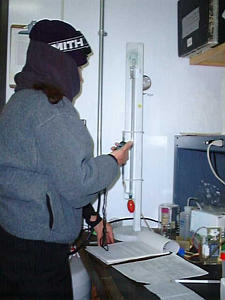27 January, 1999
Wednesday, January 27th, 1999, South Pole Station
Greetings from the very bottom of the Earth. The temperature was -
28C and we had 7 knots of wind.
The ICE TREK team left today and wewere all back to our work. We
launched an ozonesonde today, using the 6A model and 2% KI solution.
Joel started the launch while I was attending a meeting and I
continued by observing the data and making sure that the antenna
pointed in the right direction. After that I answered email
questions, set up mew videoconference times, helped at ARO's and
edited journals. I also had a chance to talk to some people of the
galley. A lot of you have asked me about what food we are eating and
who is cooking for us. I'll be ready for a report sometime next week
I am still going back and forth the buildings on skies, which I
rented, from the station. It is great and I am getting better
adjusted to this altitude.
The Wednesday night science lecture was asking the question:
Do We Live in a Flat Universe? Recent results from Viper. By Jeff
Peterson, Carnegie Mellon University
The Viper telescope is the first cosmic background telescope to
measure the size of cosmic background objects on the sky. The
measured size, about one half degree, is just the size predicted if
the universe has a flat geometry. These results indicate that the big
bang explosion was powerful enough to continue the expansion of the
universe forever.
All of this we can find out with the Viper Telescope which is at the
Dark Sector at the Martin A. Pomerantz Observatory (MAPO)
Back to ozone research to answer yesterday's question: what has been
done to save the remaining ozone layer? One of the most remarkable
effort to save the ozone layer, in my opinion, was the signing of the
Montreal Protocol which goal it was to have all countries agree to
reduce the emission of ozone-depleting substances.
THE MONTREAL PROTICOL - an agreement for countries not to use products
with ozone depleting chemicals. ) How did such an important agreement
among many countries came about?
(Excerpts from: 'Ozone Science: A Canadian Perspective on the
changing Ozone Layer')
"The signing of the Montreal Protocol on September 16, 1987 was a
remarkable and significant event in modern diplomatic history, one of
those rare occasions when individual nations subordinated economic
self-interest to the achievement of a common planetary goal. The event
was even more remarkable when one considered that it was accomplished
in spite of scientific uncertainties about detailed aspects of the
ozone depletion process and without immediate evidence of impacts on
ecosystems and human health. That an agreement was eventually reached
was due not only to an extraordinarily successful collaboration
between scientists and policymakers but also to the enormous strides
made by the international scientific community in expanding the
boundaries of ozone science". The negotiation of the protocol went on
for several years. "The conclusion of such an important and
unprecedented agreement owes much to the skill and persistency of
those who negotiated it, but a number of other important factors
contributed to this achievement. The role of the international
scientific community was parcticular valid. Although scientists were
unable to eliminate many of the uncertainties that surrounded and
still surround the stratospheric ozone issue, they were successful in
reducing the range of uncertainty, and in building a compelling case
for action. Chance played a role as well, most notably with the
recovery with the discovery of the Antarctic ozone hole in 1985. The
ozone hole did not confirm existing theories about the destruction of
the ozone layer- it only raised new questions - but it did create a
greater awareness among opinion leaders and the public that something
serious was happening to the atmosphere and that precautionary action
was necessary. An agreement also became much more likely after 1986,
when American chemical industry, one of the larger producers of CFC's
in the world abandoned its opposition of controls. "
Most countries in the world signed the Montreal Protocol. In December
of 1998, the last Montreal Protocol conference was held in Cairo.

At the BIF, I am taking the flow rate as a preparation of the ozonesonde.
Contact the TEA in the field at
.
If you cannot connect through your browser, copy the
TEA's e-mail address in the "To:" line of
your favorite e-mail package.
|
